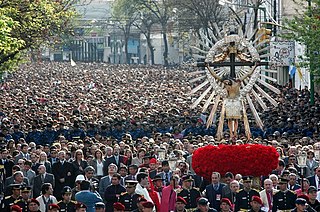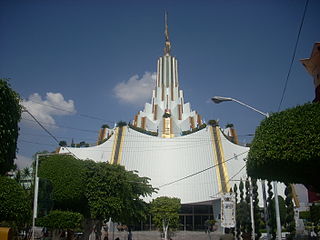Restorationism, also known as Restitutionism or Christian primitivism, is a religious perspective according to which the early beliefs and practices of the followers of Jesus were either lost or adulterated after his death and required a "restoration". It is a view that often "seeks to correct faults or deficiencies, in other branches of Christianity, by appealing to the primitive church as normative model".

Iglesia ni Cristo is an independent nontrinitarian Christian church, founded in 1913 and registered by Felix Y. Manalo in 1914 as a sole religious corporation of the Insular Government of the Philippines.

Christianity is the predominant religion in the Philippines, with the Catholic Church being its largest denomination. Sizeable minorities adhering to Islam, Dharmic religions, and indigenous Philippine folk religions are also present.

The Church of Our Lord Jesus Christ of the Apostolic Faith is a Oneness Pentecostal church with headquarters in Manhattan. It was founded in 1919 by Robert C. Lawson.

Christianity is the most widely professed religion in Argentina, with Roman Catholicism being its largest denomination. This historical background is very much due to the Spanish influence brought about through the newly conquered territories. However, affiliation with Protestant churches is increasing and immigration throughout the 20th century has brought other religions from various regions to Argentina.
The Statement of Faith of the United Church of Christ is a Christian confession of faith written in 1959 to express the common faith of the newly founded United Church of Christ, formed in 1957 by the union of the Evangelical and Reformed Church with the Congregational Christian Churches. The statement was prepared by a 28-member commission elected at the Uniting General Synod in 1957 and was formally ratified by the Second General Synod in 1959. The commission, chaired by Elmer J. F. Arndt and vice-chaired by Douglas Horton, had equal representation from the two predecessor bodies, and included six women.

The Iglesia del Dios Vivo, Columna y Apoyo de la Verdad, La Luz del Mundo —or simply La Luz del Mundo (LLDM)—is a nontrinitarian Christian denomination in the Restorationist tradition, with international headquarters in Guadalajara, Jalisco, Mexico. La Luz del Mundo practices a form of Restorationist theology centered on three leaders: Aarón—born Eusebio—Joaquín González (1896–1964), Samuel Joaquín Flores (1937–2014), and Naasón Joaquín García, who are regarded by the church as modern-day apostles of Jesus Christ.

The Philippines is ranked as the 5th largest Christian-majority country on Earth in 2010, with about 93% of the population being adherents. As of 2019, it was the third largest Catholic country in the world and was one of two predominantly Catholic nations in Asia.
The National Administrative Department of Statistics (DANE) does not collect religious statistics, and accurate reports are difficult to obtain. However, based on various studies and a survey, about 90% of the population adheres to Christianity, the majority of which (70.9%) are Roman Catholic, while a significant minority (16.7%) adhere to Protestantism.
The Pentecostal Assemblies of Jesus Christ (PAJC) is an independent association of Oneness Pentecostal churches, primarily located in the United States. Historically they have had members across the U.S. and abroad. They were formally organized in 1931. The original headquarters were located in Columbus, Ohio, later moved to St. Louis, Missouri, and then to Cleveland, Ohio. Today they are in Reesville, Ohio.
La Laguna is a municipality in the Chalatenango department of El Salvador.
The Adventist Church of Promise is an evangelical Christian denomination which is both Sabbatarian Adventist and classical Pentecostal in its doctrine and worship. It was founded in Brazil in 1932 by pastor John August Silveira, as a split-off from the Seventh-day Adventist Church.

The United Church of Christ in the Philippines is a Christian denomination in the Philippines. Established in its present form in Malate, Manila, it resulted from the merger of the Evangelical Church of the Philippines, the Philippine Methodist Church, the Disciples of Christ, the United Evangelical Church and several independent congregations.

Pedro Roldán (1624–1699) was a Baroque sculptor from Seville, Andalusia, Spain. His daughter Luisa Roldán, known as La Roldana, was also a major figure of Spanish Baroque sculpture.
Pentecostal viewpoints concerning homosexuality are varied worldwide, since there is no one organization that represents all Pentecostals. However, most Pentecostal denominations condemn homosexuality as going against scriptural teachings, though there are some affirming Pentecostal denominations.
Iglesia Evangelica Apostolica del Nombre de Jesus, also known as IEANJESUS, is the largest Ecuadorian and Peruvian Oneness Pentecostal denomination. Founded in 1959, it now counts more than 1,022 churches in Ecuador, and over 350,000 members around the world.
The Iglesia Apostólica de la Fe en Cristo Jesús frequently abbreviated IAFCJ is a Mexican/Hispanic Oneness Pentecostal denomination. Its sister organization in the United States is the Apostolic Assembly of the Faith in Christ Jesus the oldest bilingual Oneness Pentecostal denomination in the United States. The IAFCJ traces its origins to the Azusa Street Revival in Los Angeles, California in the early 1900s. Oneness Pentecostalism crossed the border into Mexico through Romana Carbajal de Valenzuela, a convert who returned to her hometown Villa Aldama, Chihuahua in northern Mexico. The IAFCJ thus began when Romana Carbajal converted twelve family members on November 1, 1914.
Antonio Aranda Lomeña was a Spanish Roman Catholic priest, theologian, and academic.








